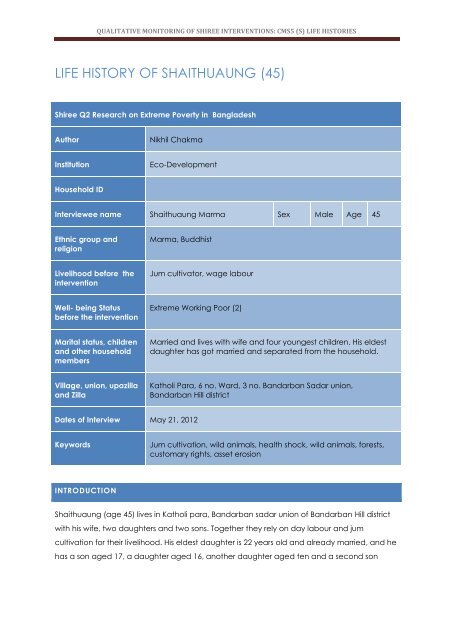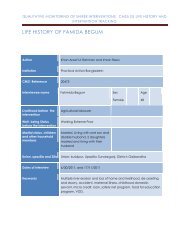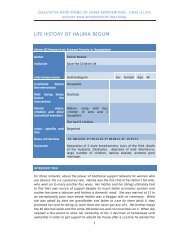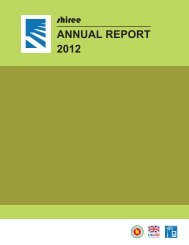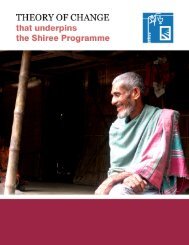qualitative monitoring of shiree interventions: cms5 (s) life histories
qualitative monitoring of shiree interventions: cms5 (s) life histories
qualitative monitoring of shiree interventions: cms5 (s) life histories
Create successful ePaper yourself
Turn your PDF publications into a flip-book with our unique Google optimized e-Paper software.
QUALITATIVE MONITORING OF SHIREE INTERVENTIONS: CMS5 (S) LIFE HISTORIESLIFE HISTORY OF SHAITHUAUNG (45)Shiree Q2 Research on Extreme Poverty in BangladeshAuthorNikhil ChakmaInstitutionEco-DevelopmentHousehold IDInterviewee name Shaithuaung Marma Sex Male Age 45Ethnic group andreligionMarma, BuddhistLivelihood before theinterventionJum cultivator, wage labourWell- being Statusbefore the interventionExtreme Working Poor (2)Marital status, childrenand other householdmembersMarried and lives with wife and four youngest children. His eldestdaughter has got married and separated from the household.Village, union, upazillaand ZillaKatholi Para, 6 no. Ward, 3 no. Bandarban Sadar union,Bandarban Hill districtDates <strong>of</strong> Interview May 21, 2012KeywordsJum cultivation, wild animals, health shock, wild animals, forests,customary rights, asset erosionINTRODUCTIONShaithuaung (age 45) lives in Katholi para, Bandarban sadar union <strong>of</strong> Bandarban Hill districtwith his wife, two daughters and two sons. Together they rely on day labour and jumcultivation for their livelihood. His eldest daughter is 22 years old and already married, and hehas a son aged 17, a daughter aged 16, another daughter aged ten and a second son
QUALITATIVE MONITORING OF SHIREE INTERVENTIONS: CMS5 (S) LIFE HISTORIESaged three. Only the youngest has ever attended school, and he currently goes to a BRACpre primary school at the village.After marriage Shaithuaung and his wife had three children in quick succession but could notsupport them and provide sufficient food. Shaithuaung was forced to sell three cows and1000 trees in order to provide for his family, and around the same time other livestock killedby wild animals. As the family’s asset base eroded the household descended into extremepoverty.To mitigate this, Shaithuaung foraged in the forests collecting bamboo and wood to sell as atemporary source <strong>of</strong> income. However he had an accident and was hospitalized for 15 days,costing 8000 taka in treatment costs. After his release from hospital he could not work for afurther 90 days. His wife and elder daughter were forced to take on day labour work for tosurvive. When he recovered he managed to find work in jum cultivation and daily labour,which again became the main income source for the family.WELL-BEING JUST BEFORE THE SHIREE INTERVENTIONIn October 2011 the household became involved with the <strong>shiree</strong> programme, though did notreceive any inputs from the project until March-Jun 2012; prior to this their wellbeing was asfollowed:IndicatorWell-being categoryDietsLivelihoods now) in terms <strong>of</strong> contribution to that years’incomeJust before the interventionWorking Extreme Poortwo meals per day, vegetables,fish once a month1.Jum cultivation2. Daily labourFor other principal adult member1. Jum cultivation2. Daily LabourProductive assets now rank them in terms <strong>of</strong> valuenone(e.g. land, livestock, rickshaws),House and homestead: ownership, condition <strong>of</strong>tenure, condition <strong>of</strong> house.Own house, occupied land bycustomary rights, bamboo madehouse ro<strong>of</strong> with Sungrass
QUALITATIVE MONITORING OF SHIREE INTERVENTIONS: CMS5 (S) LIFE HISTORIESLIFE HISTORY NARRATIVECHILDHOOD AND YOUTH (1964-88)Shaithuaung was born into a lower earning non-poor household in the village <strong>of</strong> Katholi parasurrounded by large forest and hills, the youngest <strong>of</strong> four sons and one daughter. The mainincome source <strong>of</strong> his father was jum/shifting cultivation and he had nine cows. Shaithuaungnever attended school during his childhood but can write in his own language script. Whenhe was older he helped his family members in their work which included jum cultivation andforaging in the forest. During his youth he collected a variety <strong>of</strong> forest products and couldrely on the forests for a lot <strong>of</strong> food. At the age <strong>of</strong> 14 he became involved in labour intensivework such as road construction, because, as he said, “There was no work except labouring;there were no schools and no roads at that time”.His elder brothers and sister got married when he was 16 years old. After marriage they allseparated from the parent’s house and constructed new houses in the same village. As hisparents grew older he helped out more in household activities.MARRIED LIFE AND EARLY ADULTHOOD (1989-2000)In 1989, at the age <strong>of</strong> 22, Shaithuaung got married to a girl from the same village namedKraikay Marma (then aged 18). His wife was from the same Marma community and it wastheir own choice to marry. After their marriage he separated from his parent’s house andconstructed a new house with bamboo and sungrass in the same village. Their mainlivelihoods were also jum cultivation and daily labour and he got access to two acres <strong>of</strong> landfor jum cultivation from the headman (see box 1). Due to the productivity at the time theywere able to produce a high amount <strong>of</strong> rice and other vegetables with which they couldmanage household consumption. Shaithuaung noted that productivity isn’t as highanymore.Box 1: Traditional administration systems <strong>of</strong> indigenous communities in CHTs 1The indigenous administrative system is three tiered1. Village level: The basic administrative unit is a village. Each village has a Karbari as itsleader (head), appointed from among the villagers, by the Raja directly or on therecommendation <strong>of</strong> the mauza headman. The Karbari is responsible for all matters relating tothat village.1 Source: Adopted from Rajkumari Chandra Kalindi Roy, IWGIA Document No. 99 Copenhagen 2000.
QUALITATIVE MONITORING OF SHIREE INTERVENTIONS: CMS5 (S) LIFE HISTORIES2. Mauza level: A number <strong>of</strong> villages are grouped together to form a territorial unit <strong>of</strong>jurisdiction called a mauza, <strong>of</strong> which there are more than 350 in the entire CHT. Each mauzahas a headman/woman, who is responsible for collection <strong>of</strong> revenue, preservation <strong>of</strong> peace,allocation <strong>of</strong> agricultural lands including the jums, conservation <strong>of</strong> the natural resources <strong>of</strong>the mauza and administration <strong>of</strong> customary law. They are appointed for <strong>life</strong> by the deputycommissioners in consultation with the “circle chiefs”.3. Territorial level: At the highest level it is the Raja who has authority over his/her territory.The internal matters <strong>of</strong> each village community are decided by its members, including acouncil <strong>of</strong> elders under the leadership <strong>of</strong> the Karbaris. Most matters are resolved byconsensus; if there are any disputes, the Karbari has the decisive voice. Any matters whichcannot be resolved satisfactorily, or involve members <strong>of</strong> other villages, are placed before therelevant mauza headman for decision. If required, matters are taken to the Raja, and canbe filed as a court case if necessary.Children, inheritance and new sources <strong>of</strong> incomeShaithuaung conjugal <strong>life</strong> went very well despite their poverty. In 1992, after one year <strong>of</strong>marriage, their first daughter was born. This was followed in 1995 by their first son and in 1996by a second daughter. This increased family size was a problem for the household as he wasthe only income earner; he said “I started daily labouring for the well being <strong>of</strong> my family andto feed my children. My wife couldn’t work due to our new born baby as jum cultivation ishard work”.Box 2: Jum land and cultivationJum cultivation is a traditional practice <strong>of</strong> the indigenous people <strong>of</strong> the CHTs where forest hillslopes land is cultivated on a rotational basis through a process <strong>of</strong> slashing vegetation andburning the land before cultivation.Jum cultivation is labour intensive and begins most <strong>of</strong>ten in January and February with theselection <strong>of</strong> around 1-10 acres. Each plot is demarcated under the supervision <strong>of</strong> the Mouzaheadman and the immediate forest area cleared to prevent forest fires. Vegetation isslashed in March with the preservation <strong>of</strong> valuable trees which are used for shadingvegetables and for conservation. Slashed trees used for timber are left to try for around onemonth. In April jum land is burnt and the ash acts as a fertilizer. After burning the forests, landis prepared for cultivation which takes 15-20 days.
QUALITATIVE MONITORING OF SHIREE INTERVENTIONS: CMS5 (S) LIFE HISTORIESIn late April/early May jum crops are selected sown (around 25 different agricultural cropsare produced in jum land). Subsequent months are spent weeding before the harvesting <strong>of</strong>early vegetables, as well as early variety <strong>of</strong> rice, in late July/early August. Other crops areharvested and hauled back to the home between August and October. Ginger andturmeric are harvested and processed in December/January. Land is then left fallow forapproximately 10-12 years before further cultivation.Jum land plays an important role in indigenous culture and identity, it is seen as an ancestralright and managed through customary laws.Shaithuaung’s children didn’t attend school. There was none in the village, and the nearestwas three to four km away. In 1997 he planted 1000 Gamari (Gmelina arborea) trees on theland he had been given by the Headman as a future investment, and at the same timecontinued daily labouring and collecting forests products.His father had had nine cows before Shaithuaung separated from his parent’s house.Following his father’s death due to old age his elder brother distributed all parental propertywithin the family. Despite his poverty and his brother receiving three cows, Shaithuaung onlyreceived one cow, which he was very unhappy about. He continued doing a variety <strong>of</strong>work, and became involved in wood cutting before starting to rear goats in 2000.Asset erosion and downward mobilityShaithuanung’s situation gradually worsened over the next few years as his wife gave birth totheir fourth and fifth daughters (in 2001 and 2003). His wife couldn’t work outside thehousehold as she was too busy caring for their children and they received no extracommunity or family support.By 2005 Shaithuanung had two cows and one calf bred from his inherited cow. In 2005 hesold one cow and one calf for 5000 and 2500 taka respectively. At that time he had noalternative options as he was the only member <strong>of</strong> the household capable <strong>of</strong> work. He wasn’table to invest the money productively but had to spend the entire amount <strong>of</strong> maintain hishousehold consumption. After selling the cows the household was left with only one cow andtwo goats as productive assets. Unfortunately one night in 2005 the goats were attacked andeaten by foxes. At that time he felt helpless as the goats represented a loss <strong>of</strong> 2500 taka.In 2006 his fifth daughter’s stomach grew worse and worse from worms, before dying withouttreatment. At the end <strong>of</strong> 2006 his sixth daughter was born but she died after five months dueto unknown reasons.
QUALITATIVE MONITORING OF SHIREE INTERVENTIONS: CMS5 (S) LIFE HISTORIESWhen there was no work available during the lean season Shaithuanung went deep into theforest to collect bamboo and cut wood. He left his family in the house and spent 15 to 30days in the forest. After collecting and processing the wood and bamboo they carried themfrom the forests and sold them in Bandarban for 25 taka per 100 bamboos. During the leanseason Shaithuanung borrowed ten haris 2 <strong>of</strong> paddy from the village rich men but within sixmonths he had to repay 15 Kgs <strong>of</strong> paddy.Serious injury leading to wife workingWhile cutting wood in the forest one day in 2006 Shaithuanung suffered a serious injury,accidently hitting his own left foot. His friends helped him to the hospital where he stayed for15 days and spent 8,000 taka for medical treatment. In order to raise the money fortreatment, the family were forced to sell the last remaining cow for 4,000 Taka. At the sametime the family were suffering from a lack <strong>of</strong> food but fortunately community people workedtogether to raise funds and contributed 1000 taka towards the treatment.After 15 days a medical doctor released him from the hospital, but he could not work foranother 90 days and stayed in the house. Instead his wife and elder daughter startedworking as daily labours and continued until he recovered from his injury.Out <strong>of</strong> desperation in 2007 Shaithuanung sold the gamari trees he had planted to a localtrader, receiving 5500 taka. When he had fully recovered he began again working as a daylabourer and in jum cultivation. A year later his wife gave birth to their seventh child, a son.In 2010 his eldest daughter got married to a man that she chose, he said “when they gotmarried, no money was spent for the ceremony but when they visited my house I spent 2000taka. In 2011 Shaithuanung harvested 20 haris <strong>of</strong> paddy.2 one hari is equal to approximately ten kg
QUALITATIVE MONITORING OF SHIREE INTERVENTIONS: CMS5 (S) LIFE HISTORIESCONCLUSIONDespite being born into what is defined here as a lower earning non poor householdShaithuaung fell into extreme poverty through his married <strong>life</strong>. When asked to explain thereasons behind his poverty he said, “The children were born year by year but there was n<strong>of</strong>ood to feed them, my wife couldn’t work so I had to sell all our assets. As there were noother productive assets left we became poor”.Between 1992 and 2008 Shaithuaung had seven children, two <strong>of</strong> whom died at an early age.The continuous need to feed this many mouths combined with a reliance on a small assetbase and seasonal work led Shaithuaung to systematically deplete any assets that built up.Combined with a health shock this forced his and wife and eldest daughter into wagelabour. Though Shaithuaung lived in the same village as three brothers he received littlesubstantial support from them, aside from one instance following a serious injury and beinghospitalised.
SEASONAL LIVELIHOOD OPPORTUNITY MAPType <strong>of</strong>activityDayandincomeJAN FEB MAR APRIL MAY JUNE JULY AUG SEPT OCT NOV DECJumcultivationDayJunglecutting forJumcultivationJungleclearingfor JumcultivationLeanseasonForestsBurningand landpreparationfor JumcultivationSowingRice cropsandvegetables,Turmeric,GingerFirstWeeding2 nd and3 rdWeedingHarvestingearlyvarietycrops suchleafyvegetableand riceHarvesting<strong>of</strong> RiceWagelabourGatheringforestproductIncomeDayIncomeDayincome20 haris <strong>of</strong> rice crops and leafy vegetables were used for consumption.Did wage labour 10-12 days per month but during winter wage labour were reduced to six daysMonthly he got 2500 taka from wage labour but it is seasonally dependentFour days a monthHe never sold forest products to the marketTotalincomeapproximatelyHis monthly cash income is approximately 2500 taka though this is seasonally dependent8
Life history map <strong>of</strong> Shaithuaung (45)MiddleeliteLowerearningnon-poorBorn into ahouseholdowning nine cowsSeparated from theparents house aftermarriage and built newhouse in 1990Father died andreceived a cow asinheritanceStrain <strong>of</strong> householdsize leads to asseterosionHospitalised due toinjury, high treatmentcosts force wife andchild to work in 2006Recovers fromillness,cultivates jumand marriage<strong>of</strong> daughterModeratepoorWorkingextremepoorPlanted 1000trees on jumland in 1997Death <strong>of</strong> children anddeath <strong>of</strong> assetsDestituteForced to sell trees in 20071964 1989 1997 2000 2005 2011 S10


